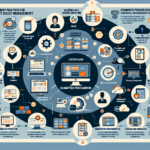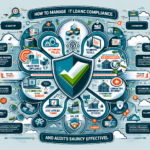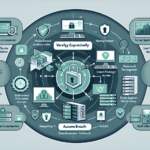Managing IT infrastructure during an acquisition can be challenging but rewarding if done strategically. As an IT manager responsible for critical areas such as datacenters, storage, backup, servers, virtualization, operating systems, Kubernetes, AI workloads, and GPU-based computing, your role is pivotal in ensuring a smooth transition. Below is a detailed guide to help you manage IT infrastructure during an acquisition:
1. Assessment and Discovery
Understand the IT landscape of both organizations:
– Inventory: Perform a detailed audit of all IT assets, including hardware, software, licenses, datacenters, servers, storage systems, backup solutions, virtualization platforms, Kubernetes clusters, AI workloads, and GPU resources.
– Compatibility: Assess compatibility between the two infrastructures (e.g., Windows vs. Linux environments, cloud vs. on-premises setups, virtualization platforms like VMware vs. Hyper-V).
– Applications & Workloads: Identify mission-critical applications, dependencies, and workloads that need to remain operational during the transition.
– Security: Evaluate the security posture of both organizations, including vulnerabilities, firewalls, access controls, and compliance.
2. Integration Planning
Develop a clear IT integration plan:
– Unified Strategy: Determine whether the infrastructures will merge, coexist, or operate separately.
– Standardization: Define standards for hardware, software, virtualization platforms (e.g., VMware, Hyper-V), container orchestration (e.g., Kubernetes), and GPU-based workloads.
– Data Migration: Plan how data will be migrated between storage systems while ensuring data integrity and minimizing downtime.
– Backup and Recovery: Ensure robust backup solutions are in place for both organizations during the transition.
– Network Integration: Merge or reconfigure networks, including IP addressing, DNS, VPNs, and firewalls.
3. Communication and Collaboration
Engage with stakeholders and teams:
– Cross-functional Teams: Collaborate with IT teams, business units, and compliance teams from both organizations to align goals.
– Transparent Communication: Keep stakeholders informed about progress, potential risks, and timelines.
– Training: Train staff on any new systems, tools, or processes introduced during the integration.
4. Infrastructure Consolidation
Optimize and consolidate IT resources:
– Datacenters: Decide whether to consolidate datacenters or leverage cloud solutions to reduce physical footprint.
– Servers and Virtualization: Merge server infrastructures and virtual environments where possible. Use tools like VMware vCenter or Microsoft System Center for centralized management.
– Storage Systems: Consolidate storage systems (SAN, NAS, cloud storage) while ensuring scalability and redundancy.
– Kubernetes & Containers: Standardize Kubernetes clusters and container orchestration strategies for application portability.
– GPU Resources: Optimize GPU resources for AI workloads, ensuring compatibility with deep learning frameworks (e.g., TensorFlow, PyTorch).
5. Security and Compliance
Ensure robust security and compliance measures:
– Access Control: Implement strict identity and access management (IAM) policies during the integration process.
– Compliance: Ensure compliance with industry regulations (e.g., GDPR, HIPAA, PCI-DSS) for both organizations.
– Penetration Testing: Conduct security tests to identify vulnerabilities in the merged infrastructure.
– Data Protection: Encrypt sensitive data during migration and ensure it remains secure.
6. Risk Management
Mitigate risks and plan for contingencies:
– Downtime: Schedule migrations and integrations during non-critical hours to minimize impact on business operations.
– Rollback Plan: Develop rollback plans in case of unexpected issues during the integration.
– Monitoring: Use monitoring tools (e.g., Nagios, Zabbix, Prometheus) to track infrastructure performance during the transition.
7. Post-Merger Optimization
Focus on long-term infrastructure improvements:
– Cloud Migration: Evaluate opportunities to move workloads to the cloud or hybrid environments for scalability and cost efficiency.
– Automation: Automate repetitive tasks using tools like Ansible, Terraform, or PowerShell to improve operational efficiency.
– AI and Machine Learning: Optimize AI infrastructure to leverage GPU resources for data analytics, training, and inference.
– Performance Tuning: Fine-tune infrastructure components (e.g., storage IOPS, network bandwidth, server utilization).
8. Documentation and Reporting
Maintain thorough documentation:
– Document all changes, configurations, and decisions made during the acquisition process.
– Create updated network diagrams, infrastructure maps, and system manuals.
– Provide regular reports to leadership on progress, costs, and outcomes.
9. Cultural Integration
Address cultural differences between IT teams:
– Foster collaboration and knowledge-sharing between IT staff from both organizations.
– Align team workflows, methodologies, and toolsets.
10. Continuous Improvement
Review and improve the IT integration strategy:
– Conduct post-merger reviews to identify lessons learned.
– Monitor infrastructure performance and user feedback to ensure alignment with business goals.
Tools and Technologies to Use
- Datacenter Management: VMware vSphere, Microsoft System Center.
- Backup Solutions: Veeam, Commvault, Dell EMC Data Protection Suite.
- Storage Systems: NetApp, Dell EMC, AWS S3, Azure Blob Storage.
- Virtualization: VMware ESXi, Hyper-V, KVM.
- Kubernetes: Rancher, OpenShift, Helm.
- GPU Workloads: NVIDIA GPU Cloud (NGC), CUDA, TensorFlow, PyTorch.
- Monitoring: Prometheus, Grafana, Nagios, Zabbix.
- Automation: Ansible, Terraform, Puppet.
By following these steps, you can ensure a smooth IT infrastructure transition during an acquisition while minimizing risks and aligning technology with business goals.





